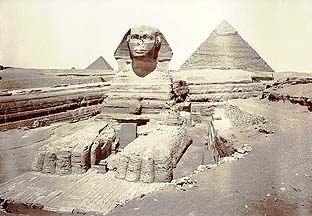The Great Sphinx at Giza

Carved from limestone bedrock during the Old Kingdom (c. 2800-2350 B.C.) as an image of Harmachis, the rising sun, the Sphinx was from time to time buried up to its neck by the encroaching Libyan sands. During the New Kingdom (c. 1560-1085 B.C.) it became popular for royal princes holding military posts in Memphis to ride their chariots across the ancient pyramid fields, perhaps in ritualized exhibition of their martial prowess. The stela of Thutmosis IV, visible in this photo between the front paws of the Sphinx, tells of how the prince Thutmosis was accustomed to drive his chariot round and round the Sphinx. One day he went to sleep in the shadow of the Sphinx, and the god Harmachis himself appeared to the young man in a dream, complaining of the sand which burdened his colossal image and promising the throne to the prince if he would clear away the sand. Evidently both Thutmosis IV and Harmachis kept their word. This photograph was taken after Émile Baraize completed his excavations of the Sphinx in 1934 and before Selim Hassan began new work on the site in 1936. The pyramid of Khafra (Chefren) is visible to the right; those of Menkaura (Mycerinus) and one of his queens to the left.
- Silver gelatin on glass
- 23.5 x 29.5 cm
- $500.00

